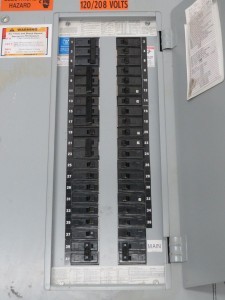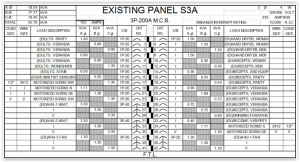208V Single Phase and 208V 3 Phase power are easy to use, but hard to understand. If you want a simple understanding but aren’t electrically minded, start with a simple analogy you can build on. I like the bicycle analogy.
Bicycle Analogy
A tandem bicycle has two people providing power with four legs (pedals). Each leg (pedal) provides power (pedal pressure) at a unique angle (pedal angle) to the center (shaft).
Look at the pedals. The four pedals (legs) are evenly spaced in a circle (360 degrees / 4 pedals = 90 degrees) around a center (pedal crankshaft).
Electrical phases are commonly called legs. 3 Phase electric motors have 3 legs (phases) evenly spaced in a circle around the center (shaft) and they move in a circle around the center (shaft) like legs on a bike.
208V 3 Phase Power
208V 3 Phase power has 3 electrical legs (phases) evenly spaced in a circle (360 degrees / 3 phases = 120 degrees) around a center (neutral). Each leg (phase) provides power (phase voltage) at a unique angle (phase angle) to the center (neutral).
208V 3 Phase power also goes by the names 208V 3 Phase 4 Wire and 208Y/120V. These are technically more accurate because they refer to the neutral.
- The “4 Wire” in 208V 3 Phase 4 Wire refers to the neutral as 4th wire.
- The” Y” in 208Y/120V refers to the neutral as the center of the Y shaped power source.
208V 3 Phase Power Panel
A 208V 3 Phase Power Panel provides 3 power circuit types (120V 1 Phase, 208V 1 Phase, 208V 3 Phase) in 7 circuit configurations based on Circuit Breaker (CB) Type (1 Pole, 2 Pole, 3 Pole) and Position (1, 2, 3, etc.) as shown below.
- Single Phase 120V – 1 Pole Circuit Breaker
- 120V 1 Phase (Phase A, Neutral)
- 120V 1 Phase (Phase B, Neutral)
- 120V 1 Phase (Phase C, Neutral)
- Single Phase 208V – 2 Pole Circuit Breaker
- 208V 1 Phase (Phase A, Phase B)
- 208V 1 Phase (Phase B, Phase C)
- 208V 1 Phase (Phase C, Phase A)
- Three Phase 208V- 3 Pole Circuit Breaker
- 208V 3 Phase (Phase A, Phase B, Phase C)
- Panel Directory (208 3 Phase 42 Circuit) explanation
- The (3) vertical lines are the three power phases (Phase A, Phase B, Phase C)
- The (21) horizontal lines are the power phase connections to the (42) circuit breaker positions
- The (18) dots are the (3) power phase to (42) circuit breaker position connections
- The (42) numbers are the (42) circuit breaker positions
CB Type vs CB Position vs Power Connection
| Circuit Breaker Type | Circuit Breaker Position | 120V 1 Phase Connection | 208V 1 Phase Connection | 208V 3 Phase Connection |
| 1 Pole | 1, 2, 7, 8, 13, 14, 19, 20, 25, 26, 31, 32, 37, 38 | Phase A and Neutral | Not Applicable | Not Applicable |
| 1 Pole | 3, 4, 9, 10, 15, 16, 21, 22, 27, 28, 33, 34, 39, 40 | Phase B and Neutral | Not Applicable | Not Applicable |
| 1 Pole | 5, 6, 11, 12, 17, 18, 23, 24, 29, 30, 35, 36, 41, 42 | Phase C and Neutral | Not Applicable | Not Applicable |
| 2 Pole | 1, 7, 13, 19, 25, 31, 37 | Not Applicable | Phase A and Phase B | Not Applicable |
| 2 Pole | 3, 9, 15, 21, 27, 33, 39 | Not Applicable | Phase B and Phase C | Not Applicable |
| 2 Pole | 5, 11, 17, 23, 29, 35, 41 | Not Applicable | Phase C and Phase A | Not Applicable |
| 3 Pole | 1, 2, 7, 8, 13, 14, 19, 20, 25, 26, 31, 32, 37, 38 | Not Applicable | Not Applicable | Phase A and Phase B and Phase C |
208V 3 Phase Power Panel Wiring
- 120V Single Phase power wiring
- Install a 1 Pole Circuit Breaker (CB)
- Connect (1) 120V 1 Phase power wire to the 1 Pole CB
- Connect (1) Neutral wire to the Neutral Bar
- 208V Single Phase power wiring
- Install a 2 Pole Circuit Breaker (CB)
- Connect (2) 208V 1 Phase power wires to the 2 Pole CB
- 208V Three Phase power wiring
- Install a 3 Pole Circuit Breaker (CB)
- Connect (3) 208V 3 Phase power wires to the 3 Pole CB
208V 3 Phase Load balancing
Ideally, the power circuit loads should be balanced across all three Power phases (Phase A, Phase B, Phase C). You can’t get it perfect, but it’s something to think about. Most Power Panels don’t have a documented load schedule. Below is an example of what one looks like.





